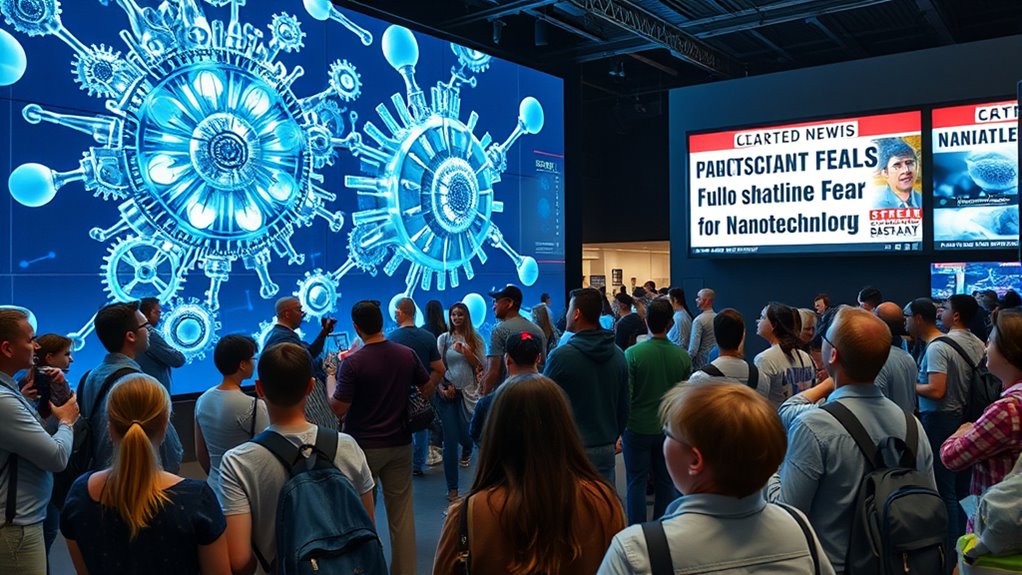Public perception of nanomachines is often clouded by myths, science fiction fears, and sensational headlines. Many believe they are large, dangerous, or uncontrollable, but in reality, these tiny devices are designed for safe medical, environmental, and industrial uses, with strict controls in place. Understanding the facts reveals a promising future. If you want to explore how responsible development and transparent communication are shaping perceptions, there’s more to uncover.
Key Takeaways
- Public fears often stem from misconceptions fueled by science fiction, such as self-replicating nanomachines and dystopian scenarios.
- Media sensationalism emphasizes worst-case outcomes, impacting public trust and understanding of current nanotechnology capabilities.
- Clear education about nanomachine applications, safety measures, and regulations can dispel myths and foster informed perceptions.
- Transparent communication regarding risks, ethical oversight, and benefits helps build societal confidence in responsible nanotechnology use.
- Promoting responsible innovation, standards, and public engagement addresses fears and encourages acceptance of nanomachines’ real-world benefits.
Common Misconceptions About Nanomachines

Many people believe that nanomachines are fictional or only exist in science fiction movies, but in reality, they are real and rapidly advancing technology. Despite this, many misconceptions persist. Some think nanomachines are dangerous, uncontrollable robots that could cause harm if released. Others believe they are large, mechanical devices visible to the naked eye, which isn’t true—nanomachines operate on a scale of billionths of a meter. Many imagine they can self-replicate endlessly, leading to fears of a “gray goo” scenario, but current technology lacks such capabilities. Additionally, some believe nanomachines are only used for military or sinister purposes. In truth, they are mostly designed for medical, environmental, and industrial applications, with strict regulations guiding their development and use. Understanding nanoscience helps clarify their actual capabilities and limitations.
The Roots of Public Fears and Concerns

Public fears about nanomachines often stem from a combination of science fiction portrayals and a lack of understanding about the technology’s current capabilities. Movies and books often depict nanomachines as uncontrollable, weaponized, or capable of mass destruction, which fuels anxiety. At the same time, many people don’t fully grasp what nanomachines can do today—they’re primarily limited to medical, environmental, and industrial applications. This gap in knowledge leads to exaggerated fears about potential misuse or unintended consequences. Additionally, historical concerns over new technologies, such as genetic modification, contribute to a cautious or fearful attitude. These roots of concern are often rooted in uncertainty, imagination, and a natural tendency to worry about unknown or misunderstood risks. Leveraging AI content clusters can help clarify realistic capabilities and dispel misconceptions surrounding nanotechnology.
Media Influence on Nanomachine Perceptions

Media representations play a significant role in shaping how people perceive nanomachines. They often highlight sensational stories, emphasizing worst-case scenarios or fictional dangers that fuel public fears. This can lead you to imagine nanomachines as uncontrollable or destructive, even when real science shows otherwise. The media’s focus on dystopian narratives overshadows positive developments and realistic applications. As a result, misconceptions spread quickly, influencing your opinions and fueling distrust. To better understand nanomachines, it’s essential to recognize how media framing impacts perceptions. Being critical of sensational headlines and seeking reliable sources helps you form a balanced view. Remember, media often exaggerates to attract attention, so questioning the narrative allows you to see the true potential and risks of nanotechnology. Additionally, understanding scientific advancements in nanomachines can help you differentiate between fiction and reality.
Scientific Realities Versus Fiction

While fiction often portrays nanomachines as tiny, autonomous robots capable of overtaking entire systems, scientific reality paints a much different picture. Currently, nanomachines are mostly experimental and require external control, often relying on chemical or physical cues. They are not self-replicating or capable of independent thought. Instead, researchers develop nanoscale tools to perform specific tasks, like targeted drug delivery or diagnostics. These devices are limited in complexity and scale, unlike the autonomous machines depicted in movies. Advances in nanotechnology focus on safety, precision, and control. While the concept of fully autonomous nanomachines remains speculative, ongoing research continues to bridge the gap between science fiction and reality, emphasizing practical applications over sensationalized capabilities. Additionally, understanding the dog names associated with various breeds can help researchers develop more dog-friendly nanotechnologies that cater to specific breed characteristics.
Potential Risks and How They Are Managed

You should understand how containment and control measures are designed to prevent nanomachines from causing unintended harm. Ethical oversight and regulations play a key role in ensuring responsible development and use. Together, these strategies help manage potential risks and build public trust in nanotechnology. Implementing comprehensive safety protocols is essential for addressing unforeseen challenges and maintaining public confidence.
Containment and Control Measures
Controlling nanomachines is essential because their tiny size and powerful capabilities pose unique risks. To prevent accidents or misuse, strict containment and control measures are in place. These include physical barriers like sealed environments, fail-safe shutdown systems, and advanced monitoring tools. Researchers also develop kill-switch mechanisms that deactivate nanomachines if needed. Additionally, robust protocols ensure safe deployment and handling, minimizing environmental or health hazards. These measures are continuously improved through testing and oversight, ensuring safety without hindering innovation. Your understanding of these controls helps build trust that nanomachines are managed responsibly. By implementing multiple layers of safeguards, scientists aim to prevent unintended release or malfunction, ensuring nanomachines serve society safely. Effective containment strategies are crucial for managing the risks associated with nanomachines.
Ethical Oversight and Regulations
As nanomachines become more integrated into society, ethical oversight and regulations are crucial to managing their potential risks. You need clear guidelines to ensure safety, privacy, and fair use. Regulatory bodies are responsible for setting standards, monitoring developments, and enforcing compliance. They evaluate new technologies for possible harm and ensure manufacturers follow strict protocols. Ethical oversight also addresses concerns about misuse or unintended consequences, like environmental damage or privacy violations. Public engagement is essential, so you can voice concerns and stay informed. Proper regulations help prevent harm, build trust, and foster responsible innovation. Without oversight, risks could escalate, leading to misinformation or fear. Additionally, implementing AI-driven data analytics can assist regulators in identifying emerging issues and ensuring compliance. Ultimately, effective management balances technological progress with societal safety, ensuring nanomachines serve the public good without compromising ethical standards.
Ethical and Regulatory Considerations

As nanomachines become more advanced, establishing clear regulatory frameworks is essential to guarantee safe development and use. You need ethical guidelines that prevent misuse and protect public interests, while risk assessment standards help identify potential hazards early. Addressing these considerations now will shape how society accepts and integrates nanotechnology responsibly. Incorporating principles from ethical hacking can also aid in developing security protocols that safeguard against malicious exploitation of nanotechnologies.
Regulatory Framework Development
Developing a regulatory framework for nanomachines is essential to address the ethical and safety concerns they raise. Clear rules help guarantee responsible research, development, and deployment, fostering public trust. You need standards that prevent misuse, manage risks, and promote transparency. Regulations should also support innovation without stifling progress.
Consider these key aspects:
- Establishing safety testing protocols to assess potential health and environmental impacts
- Defining licensing and oversight procedures for manufacturers and users
- Creating international agreements to promote consistency across borders
- Incorporating projector technology standards to ensure safe and effective deployment of nanomachines in various sectors
Ethical Use Guidelines
Establishing ethical use guidelines for nanomachines is crucial to guarantee their deployment benefits society while minimizing potential harms. You need clear principles that ensure responsible innovation, addressing issues like privacy, consent, and safety. These guidelines serve as a moral compass, guiding developers and users to prioritize human well-being and environmental protection. Transparency is essential; you should promote open communication about nanomachine capabilities and limitations. Public trust depends on ethical standards that prevent misuse, such as malicious applications or unintended consequences. Regulators and industry leaders must collaborate to create frameworks that uphold integrity and accountability. By setting these boundaries, you help foster societal acceptance and ensure nanomachines are used ethically, aligning technological progress with moral responsibility. Incorporating cultural and regional perspectives can further enhance the development of responsible guidelines, ensuring they are inclusive and respectful of diverse societal values.
Risk Assessment Standards
How can we guarantee nanomachines are safe and ethically sound before widespread use? You need robust risk assessment standards that evaluate potential hazards, long-term impacts, and ethical concerns. These standards help identify risks early, ensuring accountability and public trust. Implementing rigorous testing protocols, continuous monitoring, and transparent reporting is essential. Regulatory bodies must set clear guidelines for development and deployment, balancing innovation with safety. Public engagement is vital to address fears and misconceptions. By establishing comprehensive risk assessment standards, you create a framework that safeguards health, environment, and society while fostering responsible advancement.
- Develop standardized testing procedures and safety benchmarks
- Ensure ongoing monitoring and post-deployment evaluations
- Foster transparent communication between developers, regulators, and the public
Benefits That Can Transform Society

Nanomachines hold the potential to revolutionize society by enabling precise solutions to complex problems. They can dramatically improve healthcare through targeted drug delivery, reducing side effects and increasing treatment effectiveness. In agriculture, nanomachines may enhance crop yields, detect pests early, and minimize chemical use, promoting sustainability. Environmental challenges could also benefit; nanomachines can clean up pollutants more efficiently, breaking down hazardous waste at a microscopic level. Additionally, they could advance manufacturing processes by producing stronger, lighter materials and reducing waste. These innovations promise a future where diseases are better managed, food security is strengthened, and pollution is minimized. By harnessing nanomachines responsibly, you can help create a society that’s healthier, more sustainable, and better equipped to face global challenges.
The Role of Education in Shaping Understanding

Education plays a pivotal role in shaping how society understands nanomachines and their potential impact. When you’re informed, you can distinguish facts from myths and develop a balanced view. Quality education provides clear explanations about how nanomachines work, their benefits, and risks. It also encourages critical thinking, so you can question sensational claims and recognize credible sources. By learning about nanotechnology, you become better equipped to participate in discussions and make informed decisions.
- Understand the science behind nanomachines, reducing fears fueled by misinformation
- Recognize the difference between realistic potential and exaggerated fears
- Empower yourself to engage in meaningful conversations about technological advancements
Responsible Communication From Scientists and Developers

When scientists and developers communicate about nanomachines, their words can greatly influence public perception. Clear, honest, and carefully framed messages help prevent misunderstandings and dispel myths. You should avoid sensationalism or exaggeration, as it can fuel fears and misconceptions. Instead, focus on explaining the technology’s benefits and limitations straightforwardly. A responsible communicator acknowledges uncertainties and emphasizes ongoing research, fostering trust. Using accessible language and avoiding jargon makes information more understandable, reducing confusion. Remember, your tone matters—approaching discussions with transparency and respect encourages a more informed and open dialogue. Ultimately, responsible communication helps build a foundation of credibility, ensuring the public perceives nanomachines as a safe and promising advancement rather than a source of fear.
Building Trust Through Transparency and Engagement

Building trust with the public requires openness and genuine engagement. When you share clear, honest information about nanomachines, you help dispel myths and reduce fears. Transparency shows that you’re committed to accountability and respects the public’s right to understand new technologies. Engaging your audience involves listening to their concerns, answering questions honestly, and involving them in discussions about safety and ethics. This two-way communication fosters trust and demonstrates that you value their input. To build strong relationships, consider hosting community forums, providing accessible educational resources, and maintaining consistent updates. These efforts show that your intentions are transparent, and you’re committed to responsible innovation. Ultimately, openness and active engagement create a foundation of trust essential for positive perceptions of nanomachines.
Frequently Asked Questions
How Can Public Fears of Nanomachines Be Effectively Addressed?
You can address public fears of nanomachines by providing transparent, accessible information about their safety and benefits. Engage with communities through open dialogues, demonstrations, and educational campaigns to dispel myths. Show how regulations ensure responsible development, and share real-world examples of nanotechnology’s positive impacts. Building trust requires honesty and ongoing communication, so people feel confident in understanding and accepting nanomachines.
What Role Do Policymakers Play in Shaping Nanomachine Regulations?
Policymakers play a vital role in shaping nanomachine regulations by establishing clear safety standards, funding research, and creating oversight frameworks. You can influence this process by advocating for transparent policies that prioritize public health and environmental protection. Your engagement helps guarantee regulations keep pace with technological advances, fostering public trust. Ultimately, policymakers serve as gatekeepers, balancing innovation with safety to prevent misuse and address societal concerns effectively.
Are There International Standards for Nanomachine Safety?
No, there aren’t universal international standards for nanomachine safety yet. While scientists and regulators dream of a global code, you might find yourself waiting forever, like for that mythical safe nanobot cure. Some organizations push for guidelines, but without a standard, you could be at the mercy of rogue nanobots or unregulated innovations. Stay cautious, and keep an eye on evolving policies—your safety’s worth it.
How Can Scientists Better Communicate Complex Nanotechnology Topics?
You can better communicate complex nanotechnology topics by using clear, simple language and relatable analogies that make the concepts accessible. Engage your audience with visuals, demonstrations, and stories that illustrate real-world applications. Encourage questions and provide transparent, honest answers to build trust. Avoid jargon, and tailor your message to your audience’s knowledge level, ensuring they feel informed rather than overwhelmed by technical details.
What Are Successful Examples of Public Engagement in Nanotechnology?
You can look at successful public engagement examples like the NanoDays events, where hands-on activities make nanotechnology accessible and exciting. Participating in science festivals and community workshops also helps demystify nanotech and build trust. Engaging through social media campaigns that share clear, relatable stories about nanotechnology’s benefits further fosters understanding. These approaches actively involve the public, making complex topics approachable and reducing fears.
Conclusion
As you navigate the world of nanomachines, remember that myths and fears often cloud understanding. By staying informed, questioning sensational headlines, and engaging with transparent science, you help build trust—much like the wise alchemists of yore who sought knowledge responsibly. Embracing education and open dialogue guarantees you’re not left in the dark like a Victorian lamp, but instead, you can confidently support safe, innovative advancements that truly benefit society.









